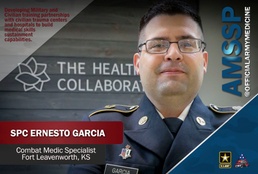
FALLS CHURCH, VA – On Feb. 14, 2020, thirty-six U.S. service members graduated from the Operation Cincinnati SMART program. The SMART program is an on-going military-civilian partnership program that allows Soldiers and other service members to work and train for two weeks in a civilian hospital. This 36-member graduation was the largest so far for the program.
“This training reminded me why I joined the Army and why I went into the medical field,” said Army Spec. Ernesto Garcia, a combat medic out of Fort Leavenworth, K.S. “I normally work in a clinic and seldom have contact with patients, but that is not the case here. I actually got to see and work with the patients beyond just doing vital signs,” he said.
SMART, which stands for Strategic Medical Asset Readiness Training Program, is part of Army Medicine’s Army Medical Skills Sustainment Program (AMSSP). The program was developed to meet the challenges of maintaining skills needed for the deployed environment while still in a garrison environment. Procedures routinely performed in an Army medical treatment facility (MTF) can sometimes fall short of duplicating procedures seen in the deployed setting. The SMART Program helps to satisfy operational readiness requirements for Army trauma teams. In addition, deployment platforms may lack the trauma case-load needed to fully sustain operational skills.
The SMART Program is made up of Operation SMART events which are two weeks long. The training provides low-density military medical occupational specialties and combat medics the opportunity to obtain “hands-on” training alongside their civilian counterparts in leading trauma centers and hospitals throughout the U.S.
This Cincinnati location included five hospitals and nine training locations during the two-week program. The hospitals included the University of Cincinnati Medical Center, Mercy Health, TriHealth, Christ Hospital, and St. Elizabeth Healthcare.
“I had no idea how much knowledge and experience I would get in these two weeks, said Army Spec. Tyler Shadwick, a medical laboratory specialist from Fort Bliss. “I would not have gotten this much exposure to a variety of conditions back at the military hospital.”
“We saw a little bit of everything here,” said Army Spec. Andrey Corlaite, a combat medic also from Fort Bliss. “I started more IVs than I can count and I treated a patient who was in full-cardiac arrest. That was the first time outside of training that I did actual chest impressions on a real patient,” he said.
“We are incredibly grateful for our civilian partnerships,” said John G. Ramiccio, the Deputy Chief of Operations and the Military-Civilian Partnerships Program Manager for the U.S. Army Medical Command. “These relationships are critical for us. Our service members are able to experience a wide-variety of medical events when they come to this training. Many of these medical situations, we do not see in the Military Health system on a regular basis; partially because we deal with a healthier population over all. This kind of training and collaboration gets after our deployment readiness goals while also focusing on our taking care of people goals,” he said.